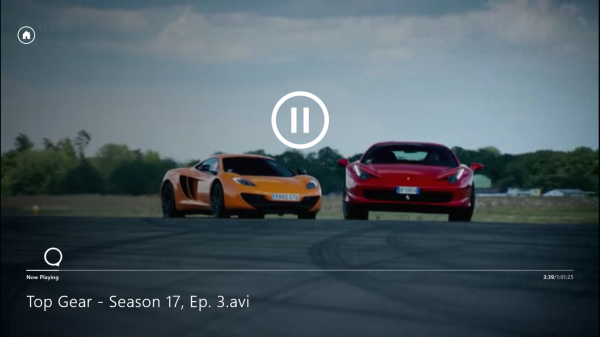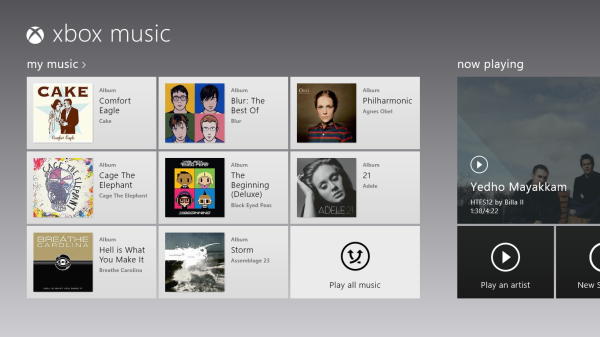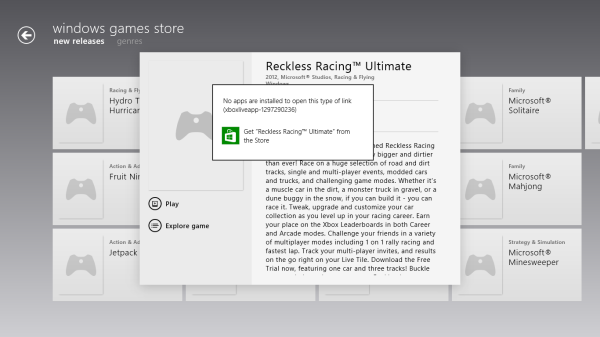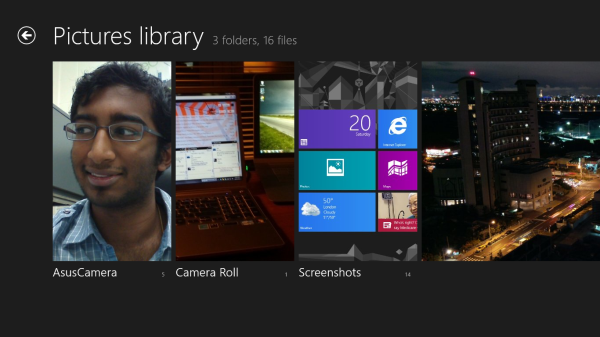The Windows RT Review
by Vivek Gowri & Anand Lal Shimpi on October 25, 2012 12:00 PM EST- Posted in
- Windows RT
- Operating Systems
- Microsoft
- Mobile
- Windows 8
- Tablets
Xbox Live: Music, Video, and Gaming
The music and video players are now part of the Xbox Live family of services, so they’re connected to Xbox Music and Xbox Video respectively. The applications are separate but are very similarly designed and laid out, with local content on the left, featured content in a central location, and content stores to the right. The bottom edge swipe brings up the ability to specify a file for playback, as well as a now-playing control bar. The music application looks quite good when snapped to the edge, with various album art from your library appearing as the background for the music controls.
Hilariously, videos can also be played back when snapped, albeit in a very small window. It’s not the best way to watch a video (who enjoys watching video content in a 320x180 window? Anyone? No takers?) but you can do it if you really want to. The video playback controls are pretty elegant in full-screen mode, and both players seem to have taken a number of interface design cues from the Zune software. I’m a huge fan of the Zune desktop software and how elegantly it operates, so I think this is great. I’m also just glad to not have to deal with Windows Media Player.
Both Xbox Music and Xbox Video look very similar to the latest Xbox dashboard update, and it’s clear that Microsoft is pushing a unified entertainment content front here. I remember when Microsoft was supporting a half dozen different music stores when the original Zune launched in 2006, so I’m just glad that they’re finally consolidating all of their services and concentrating on a single content store. Xbox has been their most successful entertainment effort to date, so it’s no surprise to see Microsoft put their faith in it for media as well.
Now, we can’t discuss Xbox without touching on gaming. Xbox Live is obviously the gaming portal of choice for Windows RT, and offers various hubs for Windows and Xbox 360 games. The Xbox Live application didn’t appear to be ready at the time of posting, with broken links and missing pictures for all the games and hubs. This is still an unreleased software (until Friday, anyways) so it’s possible that we’ll see the application be updated between now and then for a working final release. We will also have to wait until then to see what game support will be like out of the box; currently, the Xbox Windows Game store shows titles like Reckless Racing, Hydro Thunder Hurricane, Fruit Ninja, Cut the Rope, and a number of Microsoft classic titles like Minesweeper and Solitaire, amongst others.
Camera and Photos
The camera application is about as basic as you can get, with a translucent control bar that lets you switch cameras, change between still and video capture modes, set up a timer, and basic picture quality settings. Basic isn’t necessarily a bad thing though, as the application operates smoothly and quickly, with near-instant switching between modes and cameras. The controls are very straightforward - tap and hold to lock exposure is supported, and to capture an image you can just tap anywhere on the screen. It’s one of the easiest capture mechanisms out there, and fits right in with the simple UI.
The photo application pulls images from your local pictures folder and camera roll, as well as being able to connect to Facebook, Flickr, and SkyDrive. They show up as panels for each service, which show a full list of thumbnails. It’s worth pointing out that you can only see photos uploaded to Facebook from your own account, not friend’s images or pictures you’ve been tagged in. As is now the norm with tablet picture galleries, you can view images in slideshow form or just flick through them individually. For local images, the bottom edge swipe brings up an option to delete the images, as well as setting as the lockscreen image and starting a slideshow. For images on Facebook, there’s an option to view them in Facebook, though you need to actually be signed into Facebook in IE for this to work.
The overall takeaway from the camera and gallery applications is that they’re designed as minimally as possible and do exactly what they’re supposed to with a minimum of fuss. You won’t see any spectacular functionality, though the ability to slideshow through Facebook galleries is a nice touch. I think we’ll see manufacturers offer their own spin on these applications, like ASUS and their separate camera application, in an attempt to gain minor levels of platform differentiation. Microsoft has kept a pretty tight reign on the customizations allowed for the Windows Phone platform though, so I can’t see them allowing anything too invasive on Windows RT devices either.















233 Comments
View All Comments
Taft12 - Thursday, October 25, 2012 - link
You seem to have missed the way the app store phenomenon has depressed software prices. You may take quantity over quality but hardly anyone else does.SlyNine - Friday, October 26, 2012 - link
At least in your opinion. I'm with A5cent. Your point remains to be proven, right now its just your opinion.steven75 - Friday, November 2, 2012 - link
Apple's own AAA apps such as iPhoto, iMovie, Garageband, iWork are almost all $5.And they are FAR more capable than anything you can get on Metro right now.
MadMan007 - Thursday, October 25, 2012 - link
"This stage of the Tablet market"...I'm not sure what you could possibly mean there. This is the very early stage of tablet development. The iPad was released about 2 and a half years ago, that's nothing and I don't understand why people try to declare a market won when it's that new and still growing very fast.Dekker - Thursday, October 25, 2012 - link
What I mean is that developers will first write for iPad because it has an installed base of 100 million devices. Only much later will they write for less popular platforms. Some apps may not make it to RT at all. Overcoming the disadvantage of being the less attractive platform is very hard because of the self-reenforcing effects (ask Apple about their experience in the 90s when software support for the Mac faded).Not all is lost for MS, but they do not have much room for error or delay in the tablet space. As for Apple, the technology industry only grants temporary near-monopolies and they will not be on top forever.
MadMan007 - Thursday, October 25, 2012 - link
I guess if Apple continues their douchery of limiting which development tools developers can use then yeah. (Maybe they stoped that? It was in relation to Adboe tools iirc, not Flash.)Otherwise cross-platform developing will become the norm, with some necessary differences due to UI or what have you, and other tweaks as devs see fit. MS may provide some great dev tools to make this happen, even if it's just to port over to WinRT, and there are already dev tools to create apps for both WinRT and Win x86.
That last bit is where a lot of WinRT apps will come from. Devs making apps for what will be the huge Win x86 install base and just porting them to WinRT.
khanikun - Friday, October 26, 2012 - link
The difference so far is the iPad is a toy tablet. Windows RT is not. The benefit of a merger of toy tablet OS combined with a desktop OS.strangis - Friday, October 26, 2012 - link
Developers can target ALL Windows 8 computers with RT apps, which means the market will potentially be 300+ million people within a year.That far surpasses the iPad in exposure.
steven75 - Friday, November 2, 2012 - link
Except Metro is being widely panned for keyboard/mouse use.dysonlu - Friday, October 26, 2012 - link
I think the crucial points for a platform, and this may sound a bit controversial, are "hackability" and games. That's what jumpstarts a platform. Hackability: an underground scene for free apps and games or for other "illegal" use of the platform/device will lower the barrier of entry and thus increase adoption rate. The amount of people wanting free and illegal stuff can't be underestimated. Games, of course, more than any apps are what people download and buy compulsively. Games are compelling to everyone, from 7 years old to 77 years old users. Games are what people tell their friends about, they promote visibility and popularity of the platform.